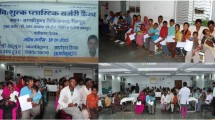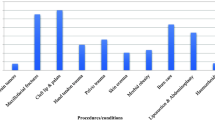Abstract
This paper describes the efforts of one plastic surgery team composed of Ghanaians from one of the major metropolitan areas in Ghana to meet the plastic surgery needs of rural Ghanaian communities. The aim was to analyze retrospectively the cases managed by the team, the difficulties which arose over a 14-year period, and the provision of recommendations for such future work. This study reviewed the medical records of patients treated during 86 outreach visits to nine centers from October 1995 to September 2009. The team, drawn from three hospitals, comprised a plastic surgeon and surgical support staff. They mostly treated Buruli ulcers, postburns scar contractures, chronic ulcers, facial clefts, tumors, and breast diseases. In all, 2,284 patients were managed during the period under review, giving an average of 163 patients per year and 254 per center. Buruli ulcers accounted for the largest group of cases treated during the outreaches (41%). Other common diagnoses were postburn scar contractures and cleft lip and palate deformities. This paper provides an example of the possibilities for surgical outreach work that exist and how challenges that come up during surgical outreach visits can be handled effectively. It also highlights the need for outreach medical work in developing countries like Ghana, especially since there is a reduction in foreign outreach medical missions. The authors encourage all stakeholders involved in health care delivery to initiate and support local medical outreach teams to provide care to rural communities.





Similar content being viewed by others
References
Hill AG, Woodfield JC (2003) Training outside of the box. ANZ J Surg 3(73):881–883
Hughes-Anderson W, House J, Aitken RJ, Rankin SL, House AK (2003) Analysis of the outcomes of a visiting surgical service to small rural communities. ANZ J Surg 73:833–835
Eberlin KR, Zaleski KL, Snyder HD, Hamdan US (2008) Medical missions for children: quality assurance guidelines for surgical outreach programs: a 20-year experience. Cleft Palate-Craniofac J 45:246–255
Solomon M (2002) Surgical mission work: an inside perspective. Proc (Bayl Univ Med Cent) 15:147–153
Wolfburg AJ (2006) Volunteering overseas: lessons from surgical brigades. N Engl J Med 354:443–445
Van der Werf TS, van der Graaf WTA, Groothius DG, Knell AJ (1989) Mycobacterium ulcerans infection in Ashanti region, Ghana. Trans R Soc Trop Med Hyg 83:410–413
Agbenorku P, Agbenorku M, Saunderson P, Lehman L (2006) The benefits of a combination of surgery and chemotherapy in the management of Buruli ulcer patients. J Sci Technol 26:6–10
Amofah GK, Sagoe-Moses C, Adjei-Acquah C, Frimpong EH (1993) Epidemiology of Buruli ulcer in Amansie West District, Ghana. Trans R Soc Trop Med Hyg 87:644–645
Agbenorku P, Akpaloo J, Amofah GK (2000) Sequelae of Mycobacterium ulcerans infection (Buruli ulcer). Eur J Plast Surg 23:326–328
Group UB (1971) Epidemiology of Mycobacterium ulcerans infection (Buruli Ulcer) at Kinyara, Uganda. Trans R Soc Trop Med Hyg 65:753–775
Amofah G, Bonsu F, Tetteh C, Okrah J, Asamoa K, Asiedu K, Addy J (2002) Buruli ulcer in Ghana: results of a national case search. Emerg Infect Dis 8(2):167–170
Stienstra Y, van der Graaf WTA, Asamoa K, van der Werf TJIPS (2002) Beliefs and attitudes toward Buruli ulcer in Ghana. Am J Trop Med Hyg 67:207–213
Forjuoh SN, Guyer B, Ireys HT (1996) Burn-related physical impairments and disabilities in Ghanaian children: prevalence and risk factors. Am J Public Health 86:81–83
Khan AA, Rawlins J, Shenton AF et al (2007) The Bradford Burn Study: the epidemiology of burns presenting to an inner city emergency department. Emerg Med J 24:564–566
Attia AF, Sherif AA, Massoud MN, Abou-Nazel MW, Arafa MA (1997) Epidemiological and sociocultural study of burn patients in Alexandria, Egypt. East Med Health J 3:451–461
Rajpura A (2002) The epidemiology of burns and smoke inhalation in secondary care: a population-based study covering Lancashire and South Cumbria. Burns 28(2):121–130
Subrahmanyam M (1991) Topical application of honey in treatment of burns. Br J Surg 78:497–498
Ytterstad B, Sogaard AJ (1995) The Harstad Injury Prevention Study: prevention of burns in small children by a community-based intervention. Burns 21:259–266
Ashraf FA, Aida AS, Ahmed MM et al (1997) Epidemiological and sociocultural study of burn patients in Alexandria, Egypt. East Mediterr Health J 3:452–461
Agbenorku P, Agbenorku M, Sefenu R, Matondo P, Osei D (2007) Endemicity of cleft lip/palate in a rural community in south-east Ghana. J Sci Technol 27(1):45–50
Agbenorku P, Akpaloo J, Turkson E, Agbenorku M (2007) Breast diseases including breast developmental anomalies in Kumasi, Ghana. Niger J Plast Surg 3(1):11–16
Maki J, Qualls M, White B, Kleefield S, Crone R (2008) Health impact assessment and short-term medical missions: a methods study to evaluate quality of care. BMC Health Serv Res 8:121–125
d-Agostino S, Del Rossi C, Del Curto S, Attanasio A, Fontichiari S, Barro L (2001) Surgery of congenital malformations in developing countries: experience in 13 humanitarian missions during 9 years. Pediatr Med Chir 23:117–121
Acknowledgements
We very much appreciate the meals provided by the Managing Director of the Cisneros Villa Resort, a leading hotel at Sogakope, one of the outreach centers. Also, we thank the management of the South Tongu District Hospital at Sogakope for provision of lunch to the team members in the last 2 years of the visits. This gesture had prompted the team to continue the visits there. We also thank the entire centers for accepting to work with our team. And, of course, we thank all the patients who gave us the honor to treat them.
Author information
Authors and Affiliations
Corresponding author
Rights and permissions
About this article
Cite this article
Agbenorku, P., Agbenorku, M., Bentsir-Elegba, E. et al. Multicenter plastic surgery outreach services for underserved Ghanaian communities. Eur J Plast Surg 34, 111–118 (2011). https://doi.org/10.1007/s00238-010-0482-9
Received:
Accepted:
Published:
Issue Date:
DOI: https://doi.org/10.1007/s00238-010-0482-9




